Papers by Christophe Demaziere

HNPS Advances in Nuclear Physics, Apr 1, 2019
This paper presents the development of a neutron noise simulator for fine-mesh applications. The ... more This paper presents the development of a neutron noise simulator for fine-mesh applications. The neutron noise of power nuclear reactors deals with the fluctuations of the neutron flux that are induced by fluctuations or oscillations of the reactor properties, i.e. displacement of core components, temperature or density variations, etc. Since the appearance of these perturbations can be problematic for the operation of nuclear reactors, it is desirable to be able to analyze their possible effects. The comparison between the modelling of such perturbations and possible measurements also gives the possibility to determine the driving perturbation in an operating nuclear reactor. One modelling approach is to solve numerically the neutron noise diffusion equation. This paper presents CORE SIM+, an under-development numerical tool oriented to neutron noise problems that require the fine-mesh spatial discretization of the reactor core.

Annals of Nuclear Energy, May 1, 2021
The investigation of neutron noise is key to several applications in nuclear reactor physics, suc... more The investigation of neutron noise is key to several applications in nuclear reactor physics, such as the detection of control rod or assembly vibrations and the diagnostic of coolant speed and void fraction. In this paper we will elucidate some aspects of the noise equations in the Fourier domain, for the case of periodic fuel rod vibrations with frequency ω 0 in a small symmetrical system in which the perturbation is centrally located. We will in particular focus on the double frequency effect, i.e., the emergence of a noise component at 2ω 0 (possibly stronger than the one at the fundamental frequency ω 0). Our analysis will be carried out without truncating the noise source at the first order and in the context of a non-perturbative approach (i.e., without resorting to linearization). For this purpose, we will select a simple benchmark configuration that is amenable to accurate reference solutions obtained by solving the exact timedependent transport equations. The analysis carried out in this work suggests that the non-perturbative noise equations are mandatory in order to properly discriminate the possible emergence of double frequency effects in neutron noise, especially in view of comparing simulation results to experimental data.

Zenodo (CERN European Organization for Nuclear Research), Sep 6, 2018
In this work, a novel deep learning approach to unfold nuclear power reactor signals is proposed.... more In this work, a novel deep learning approach to unfold nuclear power reactor signals is proposed. It includes a combination of convolutional neural networks (CNN), denoising autoencoders (DAE) and k-means clustering of representations. Monitoring nuclear reactors while running at nominal conditions is critical. Based on analysis of the core reactor neutron flux, it is possible to derive useful information for building fault/anomaly detection systems. By leveraging signal and image pre-processing techniques, the high and low energy spectra of the signals were appropriated into a compatible format for CNN training. Firstly, a CNN was employed to unfold the signal into either twelve or forty-eight perturbation location sources, followed by a k-means clustering and k-Nearest Neighbour coarse-to-fine procedure, which significantly increases the unfolding resolution. Secondly, a DAE was utilised to denoise and reconstruct power reactor signals at varying levels of noise and/or corruption. The reconstructed signals were evaluated w.r.t. their original counter parts, by way of normalised cross correlation and unfolding metrics. The results illustrate that the origin of perturbations can be localised with high accuracy, despite limited training data and obscured/noisy signals, across various levels of granularity.
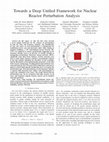
Zenodo (CERN European Organization for Nuclear Research), Nov 21, 2018
In this paper, we take the first steps towards a novel unified framework for the analysis of pert... more In this paper, we take the first steps towards a novel unified framework for the analysis of perturbations in both the Time and Frequency domains. The identification of type and source of such perturbations is fundamental for monitoring reactor cores and guarantee safety while running at nominal conditions. A 3D Convolutional Neural Network (3D-CNN) was employed to analyse perturbations happening in the frequency domain, such as an absorber of variable strength or propagating perturbation. Recurrent neural networks (RNN), specifically Long Short-Term Memory (LSTM) networks were used to study signal sequences related to perturbations induced in the time domain, including the vibrations of fuel assemblies and the fluctuations of thermal-hydraulic parameters at the inlet of the reactor coolant loops. 512 dimensional representations were extracted from the 3D-CNN and LSTM architectures, and used as input to a fused multi-sigmoid classification layer to recognise the perturbation type. If the perturbation is in the frequency domain, a separate fully-connected layer utilises said representations to regress the coordinates of its source. The results showed that the perturbation type can be recognised with high accuracy in all cases, and frequency domain scenario sources can be localised with high precision.
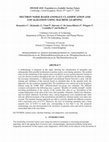
Zenodo (CERN European Organization for Nuclear Research), Apr 2, 2020
A methodology is proposed in this paper allowing the classification of anomalies and subsequently... more A methodology is proposed in this paper allowing the classification of anomalies and subsequently their possible localization in nuclear reactor cores during operation. The method relies on the monitoring of the neutron noise recorded by in-core neutron detectors located at very few discrete locations throughout the core. In order to unfold from the detectors readings the necessary information, a 3-dimensional Convolutional Neural Network is used, with the training and validation of the network based on simulated data. In the reported work, the approach was also tested on simulated data. The simulations were carried out in the frequency domain using the CORE SIM+ diffusion-based two-group core simulator. The different scenarios correspond to the following cases: a generic "absorber of variable strength", axially travelling perturbations at the velocity of the coolant flow (due to e.g. fluctuations of the coolant temperature at the inlet of the core), fuel assembly vibrations, control rod vibrations, and core barrel vibrations. In all those cases, various frequencies were considered and, when relevant, different locations of the perturbations and different vibration modes were taken into account. The machine learning approach was able to correctly identify the different scenarios with a maximum error of 0.11%. Moreover, the error in localizing anomalies had a mean squared error of 0.3072 in mesh size, corresponding to less than 4 cm. The proposed methodology was also demonstrated to be insensitive to parasitic noise and will be tested on actual plant data in the near future.

The use of non-intrusive techniques for monitoring nuclear reactors is becoming more vital as wes... more The use of non-intrusive techniques for monitoring nuclear reactors is becoming more vital as western fleets age. As a consequence, the necessity to detect more frequently occurring operational anomalies is of upmost interest. Here, noise diagnostics-the analysis of small stationary deviations of local neutron flux around its time-averaged valueis employed aiming to unfold from detector readings the nature and location of driving perturbations. Given that in-core instrumentation of western-type light-water reactors are scarce in number of detectors, rendering formal inversion of the reactor transfer function impossible, we propose to utilise advancements in Machine Learning and Deep Learning for the task of unfolding. This work presents an approach to such a task doing so in the presence of multiple and simultaneously occurring perturbations or anomalies. A voxel-wise semantic segmentation network is proposed to determine the nature and source location of multiple and simultaneously occurring perturbations in the frequency domain. A diffusion-based core simulation tool has been employed to provide simulated training data for two reactors. Additionally, we work towards the application of the aforementioned approach to real measurements, introducing a self-supervised domain adaptation procedure to align the representation distributions of simulated and real plant measurements.
Problem Case<br> • We aim to unfold reactor transfer function to provide core diagnostics.&... more Problem Case<br> • We aim to unfold reactor transfer function to provide core diagnostics.<br> • Derivation of core perturbation characteristics to classify and locate its origin.<br> • Yet this is challenging due to the limited number of neutron detectors in<br> western type reactors.<br> • We ask, can we use machine learning to successfully approximate the reactor<br> transfer function?<br> • However, to effectively train ML algorithms large quantities of data are<br> required. More details can be found in the presentation file

In this report, some of the work performed in the framework of the X-TREAM project (with X-TREAM ... more In this report, some of the work performed in the framework of the X-TREAM project (with X-TREAM standing for neXt generation numerical Techniques for deterministic REActor Modelling) is reported. The work was supported by the Nordic Thermal Hydraulic Network (NORTHNET). The focus of the report is on the tasks 3a and 3b (elaboration of 1-D test cases and comparisons of non-linear inconsistent/consistent methods) and on the task 4a (recommendations for non-linear consistent reactor safety simulations). A simplified one-dimensional Boiling Water Reactor (BWR) model in steady-state conditions was developed to study the efficiency of the Jacobian-Free Newton Krylov (JFNK) method to solve strongly non-linear multi-physic problems, such as the one corresponding to BWR behaviour, where the interdependence between neutron transport, fluid dynamics and heat transfer needs to be resolved. The modelling assumptions were chosen so that the physics of BWRs could be properly accounted for with an as simple as possible model. It was found that there is little advantage of solving each of the mono-physics problems using a JFNK approach and iterating between the various solvers until convergence is reached. As noticed with classical operator splitting approaches, such a solver is prone to oscillatory behaviour due to the strong physical coupling between coolant density/fuel temperature and the distributions of neutrons in space/energy. Such oscillations can only be overcome by using some relaxation factor, which results in slow convergence of the overall multi-physics problem. On the other hand, it was also demonstrated that solving the entire multi-physics problem simultaneously using JFNK is a very powerful technique. The robustness of this technique nevertheless relies on two important aspects: the necessity to create a good enough initial guess to be used by the JFNK algorithm and the need to properly precondition the problem. For the former, using a non-linear Gauss-Seidel technique was proven to provide such an acceptable guess. For the latter, an efficient preconditioner was found to have the following characteristics: separate preconditioning of the neutron transport problem, no preconditioning of the heat transfer problem, preconditioning of the fluid dynamics problem where the crossdependencies between the void fraction and the phasic velocities are resolved and where the pressure field is treated independently. Based on these characteristics, an analytical preconditioner using first-order (i.e. linear) approximations of the balance equations and relying on a simpler formulation of the problem solved was derived and demonstrated to be efficient. The development of such an analytical preconditioner, which is the key condition to be fulfilled for a multi-physics problem to be solved using a JFNK technique, is nevertheless a major undertaking. The possibility to use a linearly-approximated preconditioner, knowing the structure of the desired preconditioner, was also proposed. It was found to be an interesting alternative when the development of an analytical Jacobian is either too difficult (due to complex models being used in the problem being solved) or when the models are not accessible ("black-box" approach).
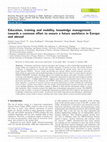
EPJ Nuclear Sciences & Technologies, 2023
Continuous and future-oriented education and training as well as knowledge management for young t... more Continuous and future-oriented education and training as well as knowledge management for young talents are required for the safe and reliable operation of nuclear reactors and nuclear facilities in Europe. A dedicated line of collaborative projects addresses the specific needs, such as lack of personnel (project ENEN+: "attract, retain and develop new nuclear talents beyond academic curricula"). State-of-the-art approaches and in-depth knowledge are provided when it comes to reactor physics (project GRE@T-PIONEeR: "graduate education alliance for teaching the physics and safety of nuclear reactors") or nuclear radiochemistry (project A-CINCH: "augmented cooperation in education and training in nuclear and radiochemistry"). A highly skilled nuclear engineer must undergo experimental work to better observe theoretical principles at work. Following the ENEEP (European nuclear experimental educational platform) initiative, a network of research reactors and special laboratories is made available for performing such activities. Another issue found is that the results of Euratom-funded research activities are spread across multiple platforms and websites making it difficult to find relevant information within a reasonable timeframe. Such a situation requires the application of knowledge management actions. The PIKNUS project aims to define a concept of a knowledge management method and tool to improve the sharing and availability of Euratom research results. All projects successfully demonstrate that European collaboration could address certain needs to attract, develop and retain young talents in future-oriented nuclear fields.

The neutron flux measured in a nuclear reactor is characterized by fluctuations around a main tre... more The neutron flux measured in a nuclear reactor is characterized by fluctuations around a main trend. These fluctuations are known as reactor neutron noise, and they may allow to identify anomalies in the reactor core. In this context, the CORTEX – COre monitoring Techniques and EXperimental validation and demonstration project, supported by the European Commission, aims at studying reactor neutron noise induced by different types of perturbations (e.g. vibrations of reactor components), and developing core monitoring techniques from the analysis of reactor neutron noise. When simulating reactor neutron noise, the reactor transfer function is needed. The reactor transfer function describes the system response to possible perturbations, and it can be modelled with the neutron transport equation. Most of the past work in this area relies on neutron diffusion theory. However, recent efforts focus on advanced computational capabilities that can provide more detailed insights into neutron noise problems and be used to assess the limitations of the diffusion approach. In the CORTEX project, Chalmers University of Technology is building a neutron noise simulator with a high-order approximation of the neutron transport equation. The equations are discretized according to a finite difference scheme for the spatial variable, a discrete ordinates approximation for the angle, and a multi-group formalism for the neutron energy. The simulation consists of two steps. The first step solves the criticality problem and calculates the static neutron flux. The second step determines the neutron noise in the frequency domain with respect to the prescribed neutron noise source and the static neutron flux previously estimated. The numerical solution of the equations is obtained from an iterative procedure. This is a computationally intensive task because a converged solution may require a very large number of iterations. A crucial factor in the reduction of the iterations is the implementation of a technique for the acceleration of the algorithm. For static calculations, methods such as the Diffusion Synthetic Acceleration (DSA) and the Coarse Mesh Finite Difference (CMFD) acceleration have been widely investigated. To some extent, these techniques have also been applied to time-dependent problems. On the other hand, no study on acceleration of neutron noise calculations in the frequency domain have been reported in the open literature. The current work also explores the extension of DSA and CMFD methods to the case of frequency-domain neutron noise simulations. Preliminary results will be presented for neutron noise calculations in a 2-dimensional heterogeneous system, with 2-energy groups.
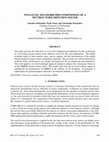
This paper presents the utilization of a two-level multigrid preconditioner for the acceleration&... more This paper presents the utilization of a two-level multigrid preconditioner for the acceleration<br> of a two-energy-group neutron noise diffusion solver for fine grid applications. The highly<br> localized nature of most neutron noise sources requires the fine discretization of the spatial<br> domain leading to large systems of algebraic equations. These systems are solved with iterative<br> methods whose performances are usually determined by the accompanying preconditioners.<br> This work applies a two-level multigrid approach aiming to enhance the convergence behavior<br> of the GMRES iterative linear solver. The results show that the two-level scheme improves<br> significantly the performance of GMRES in the solution of two problems. In particular, it<br> outperforms two general-purpose alternative acceleration methods, i.e. ILU(0) and ILUC.

In this chapter, solving the multi-physics problem related to nuclear reactor cores is dealt with... more In this chapter, solving the multi-physics problem related to nuclear reactor cores is dealt with. By multi-physics, the coupling between the neutronic fields and the thermal-hydraulic fields is considered, although the discussion could be extended to the coupling with other physics. In the first part of this chapter, the various aspects of multi-physics coupling are highlighted. Those include whether the multi-physics problem is solved in a segregated or in a monolithic manner, both from a numerical and a code implementation viewpoint; the description of the coupling terms between the various mono-physics solvers and of the corresponding non-linearities; and the type of information being exchanged between the various mono-physics solvers. The second part focuses on the preparation of the macroscopic material data (cross-sections, diffusion coefficients and discontinuity factors) as functions of the thermal-hydraulic variables, among others. Thereafter, the neutronic to thermal-hydr...
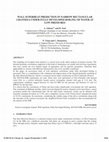
The modeling of two-phase heat transfer is a crucial issue in the safety analysis of nuclear reac... more The modeling of two-phase heat transfer is a crucial issue in the safety analysis of nuclear reactors. The thermal-hydraulic correlations employed in this kind of simulations are usually derived from experiments that were carried out over limited ranges of parameters and for specific geometries. Therefore their applicability to systems with different characteristics has to be carefully scrutinized. In this paper, an assessment study of wall superheat correlations under fully developed boiling is presented. This is a contribution to the validation and improvement of the thermal-hydraulic modeling of the Jules Horowitz Reactor, which is a research reactor under construction at CEA-Cadarache (France). The SULTAN-JHR experiments are used. These tests were performed at CEA-Grenoble with upward water flow in a vertical uniformly heated narrow rectangular channel with gap of 2.16 mm. The experimental conditions ranged between 0.2 and 0.9 MPa for the pressure and between 0.5 and 4.4 MW/m2 f...

This paper deals with the development of a novel method for performing Monte Carlo calculations o... more This paper deals with the development of a novel method for performing Monte Carlo calculations of the effect, on the neutron flux, of stationary fluctuations in macroscopic crosssections. The basic principle relies on the formulation of two equivalent problems in the frequency domain: one that corresponds to the real part of the neutron balance, and one that corresponds to the imaginary part. The two equivalent problems are in nature similar to two subcritical systems driven by external neutron sources, and can thus be treated as such in a Monte Carlo framework. The definition of these two equivalent problems nevertheless requires the possibility to modify the macroscopic cross-sections, and we use the work of Kuijper, van der Marck and Hogenbirk to define group-wise macroscopic cross-sections in MCNP. The method is illustrated in this paper at a frequency of 1 Hz, for which only the real part of the neutron balance plays a significant role and for driving fluctuations leading to n...

This paper presents an assessment study of criteria for the prediction of the Onset of Flow Insta... more This paper presents an assessment study of criteria for the prediction of the Onset of Flow Instability (OFI) in heated vertical narrow rectangular channels with downward flow. The onset of flow instability is a limiting safety issue in nuclear research reactors, since it may lead to flow starvation and eventually boiling crisis in some of the core channels. The experimental database consists of OFI tests at low pressure, with gap sizes between 1.37 and 3.23 mm, and with uniform and non-uniform heat flux profiles. Two typologies of criteria were tested, following a global and local strategy, respectively. According to the global approach, the Whittle-Forgan and Stelling criteria only use global system parameters to predict OFI. Relatively good results can be obtained over the whole database. The local approach is based on the prediction of the Net Vapor Generation (NVG) along the channel. The standard Saha-Zuber correlation fails to capture OFI for Peclet numbers lower than 70000. O...
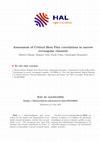
The aim of the work is to assess different CHF correlations when applied to vertical narrow recta... more The aim of the work is to assess different CHF correlations when applied to vertical narrow rectangular channels with upward low-pressure water flow. This is a contribution to the improvement of the thermal-hydraulic modeling of the Jules Horowitz Reactor, which is a research reactor under construction at CEA-Cadarache (France). For this purpose, 46 CHF tests from the SULTAN-JHR experimental database were used. These experiments were performed at CEA-Grenoble in two vertical uniformly heated rectangular channels with gaps of 1.51 (SE3: 20 tests) and 2.16 mm (SE4: 26 tests). The experimental conditions ranged between 0.38 and 0.87 MPa for the outlet pressure, between 1200 and 6600 kg/m2/s for the mass flux, between 56.4 and 156.4 °C for the inlet liquid sub-cooling and between -0.01 and 0.12 for the outlet steam quality. Several models were tested. The Groeneveld look-up tables, which were developed mainly with experiments in pipes, significantly over-estimate the CHF. Furthermore, t...

Modelling of Nuclear Reactor Multi-physics, 2020
Abstract In this chapter, the methods used for solving the neutron transport equation at the cell... more Abstract In this chapter, the methods used for solving the neutron transport equation at the cell and assembly levels are presented. First, the treatment of the energy dependence of the microscopic cross-sections is dealt with, and the so-called multi-group formalism derived accordingly. Special emphasis is given to the preparation of the multi-group data for resonant species. The numerical algorithms used for solving for the energy-dependence of the neutron flux are then generically derived. Thereafter, the typical methods used for solving for the neutron flux at the pin cell level and at the fuel assembly level are derived. Since such methods assume an infinite system of fuel pins or fuel assemblies, a correction of the solution is carried out so that the system is representative of a critical system. Based on those three computational steps, the fine structure of the energy- and space-dependence of the neutron flux is finally determined. The modelling of fuel depletion is thereafter presented. The chapter ends with explaining how the macroscopic cross-sections are prepared for subsequent core calculations, based on the results obtained at the cell and assembly levels.

In this paper the neutron noise, induced by spatially randomly distributed noise sources is inves... more In this paper the neutron noise, induced by spatially randomly distributed noise sources is investigated. The prime example of such a case is the neutron noise induced by temperature fluctuations in a PWR core, where the temperature fluctuations in the separate channels (radial positions) are only weakly correlated and their space dependence can only be specified in a statistical sense. Solutions are given for the auto- and cross-spectra of the neutron noise, in terms of the spatial cross-spectra of the noise source (temperature fluctuations). The spatial structure of the neutron noise spectrum is investigated quantitatively as a function of the frequency and the correlation length of the perturbation. The validity of the point kinetic approximation is also investigated. It is found that in the low frequency limit, point kinetics dominates even if the noise source correlation length is zero, i.e. the noise source is completely uncorrelated in space. On the other hand, in systems of realistic sizes and at plateau frequencies, i.e. at around a few Hz, noticeable deviations occur from point kinetics if the source correlation length is much smaller than the system size. The magnitude of this deviation is only a few percents at plateau frequencies in the present 1-D model, but by extrapolation it can be expected to be much larger in realistic 2-D calculations. This latter result bears importance for the determination of the moderator temperature coefficient (MTC) with noise methods, where usually a point kinetic core response is assumed in the evaluation of measurements.

This paper presents a so-called neutron noise simulator, essentially an algorithm to calculate th... more This paper presents a so-called neutron noise simulator, essentially an algorithm to calculate the dynamic transfer function, and its use in a procedure allowing to locate a noise source from the neutron detector readings. The noise simulator relies on the two-group diffusion approximation in 2-D. Benchmarking of this calculator versus analytical solutions showed that the finite difference discretisation scheme used in the simulator was accurate in case of homogeneous cores and a central noise source. The localisation algorithm was found to give correct results as long as one single noise source exists in the core and when the transfer function from the removal cross-section noise to the thermal neutron noise was used. Applying this localisation procedure to the Forsmark-1 BWR (Sweden) when a local instability event occurred (cycle 16) pointed out, via the use of an appropriate set of detectors, a region close to where an unseated fuel element was discovered.


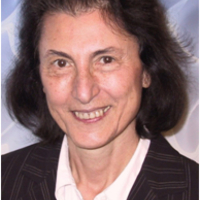





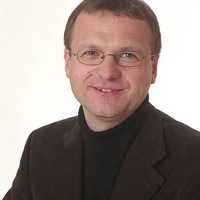
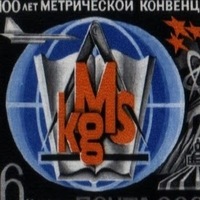
Uploads
Papers by Christophe Demaziere